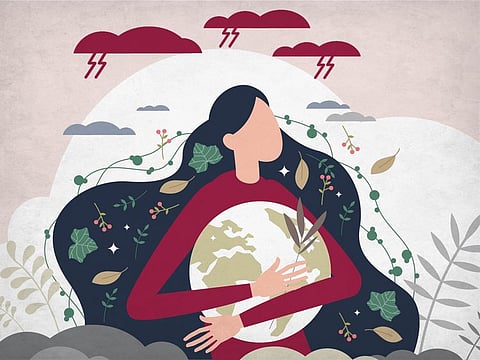Climate action: How women may save our imperilled planet
In the battle between Mother Nature and human nature, decisions are often made by women

Mother Nature has had it with her brood. If you can’t see that, you haven’t been paying attention.
Earth provides nutrition and sustenance. She coddles us and protects us. And what have we done in return? We treat her the way we too often treat our mothers. We ignore her advice. We place our needs above hers. We imagine she can magically make any problem go away — perhaps because we take for granted the toil of our real mothers who dusted us off when we faltered and stretched a pound of meatloaf to feed a family of six.
And now, as we can plainly see, we have underestimated her wrath.
Fires. Floods. Mudslides. Rivers and reservoirs drying up. Record heat. Rising shorelines. Glacial melting. The Earth is in peril, and many are finally realising they can no longer think of Earth as open armed, dispensing blessings and bounty to us — especially if we take no steps to curb the activities and habits that have sent carbon dioxide emissions soaring.
The defining struggle of our time, and our future, will be the tension between Mother Nature and human nature. So, more of us need to think differently about who and what we are dealing with here.
Embracing science behind climate change
That seems to have finally begun. In a season of catastrophic, deadly and too-common extreme weather events, there are signs that even people who were hesitant to embrace the science behind climate change are waking up to the threat.
The Pew Research Center found that more than 60% of Americans view global warming as a major threat — the highest share going back to 2009 — and 65% want the US government, for instance, to do more to reduce the effects of climate change. Six in 10 Trump voters support regulating, or even possibly taxing the pollution that causes climate change.
These are significant shifts, but they are not nearly enough of a course correction to reverse the damage we have already done. Governments can’t do this alone. Individuals are going to have to make fundamental changes.
Let’s start with our ideas about who’s really in charge of our fate. The idea of adopting a maternal symbol to represent the Earth may have been an early effort to moderate individual behaviour. Don’t we all want to avoid disappointing our mamas? The symbol of Mother Nature in the Western world has roots in Greek and Incan mythology. It’s a shame that, over time, she lost some of her edge.
In Andean culture, Pachamama was both doting and demanding. She protected her subjects, but according to lore, also insisted that they care for the home she provided. In essence, she demanded respect. Western Europeans and then Americans adopted a more passive figure, rendered as a benevolent sprite with contented woodland creatures frolicking around her dainty feet.
Mother Nature
If artists were asked to imagine Mother Nature in this season of unbridled water and heat, they would be more likely to sketch a character with a palm to her forehead or her hands on her hips. I see a woman scorned — a mother who doesn’t care that she’s yelling loud enough for the whole neighbourhood to hear because her selfish and self-centred charges left the freezer open, ignored recycling rules and dared to play with matches in the middle of a drought.
But however old fashioned our notions, and accounting for the sensitivity around gender norms, the irony is that women in general and mothers in particular are uniquely positioned to lead the on-the-ground battle to deal with the growing climate crisis.
No one is letting men of the hook, but if you check the lists that tick through the 10 to 12 things that we as individuals can do immediately to reduce our carbon footprint and conserve resources, most are actions most often influenced or controlled by women: Eat less meat, buy more efficient appliances, limit food waste, drive electric or hybrid cars, eliminate bottled water, lower thermostats (in winter), try composting and use long-lasting light bulbs.
What people buy and what people do represent the first line of defence, and in many cases those decisions are made by or strongly influenced by women, says Diane MacEachern, author of “Big Green Purse: Using Your Spending Power to Create a Cleaner, Greener World.” “Women have this incredible purchasing power because women spend over 80% of every consumer dollar in the marketplace.”
So along with taking the steps we’ve resisted, let’s retire our singular caricature of Mother Nature and let her toss away her crown of wildflowers and eucalyptus. Those images seem pulled from a fairy tale in the first place. Anyone who has spent a day camping, climbing, weeding, hiking, gardening or rowing would scoff at the idea of flowing robes and satin ribbons in the great outdoors.
In that battle between Mother Nature and human nature, the decisions made by women, girls and yes, actual mothers may ultimately save our imperilled planet. That’s something I’m certain she would applaud.
Michele L. Norris is a columnist and consultant for Post Opinions and founding director of The Race Card Project
Washington Post
Sign up for the Daily Briefing
Get the latest news and updates straight to your inbox








